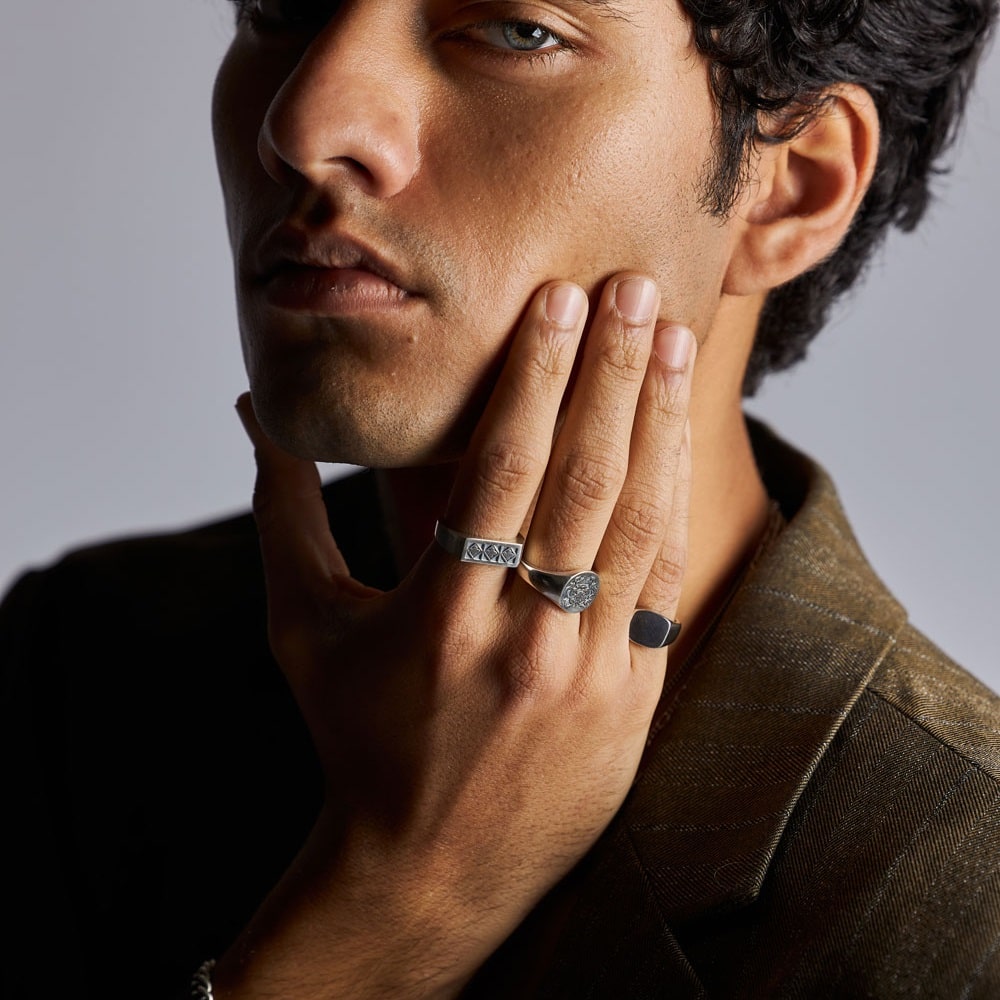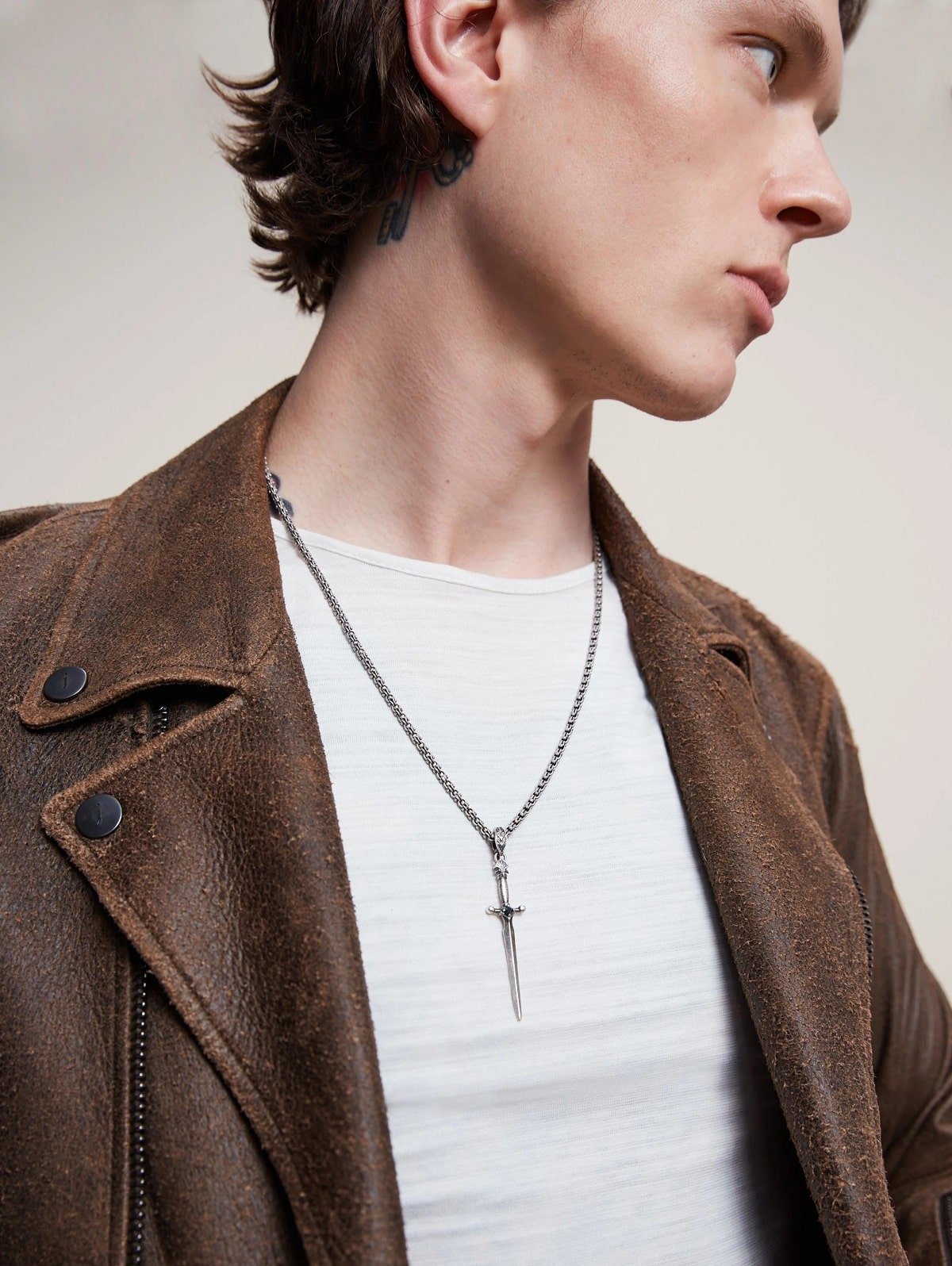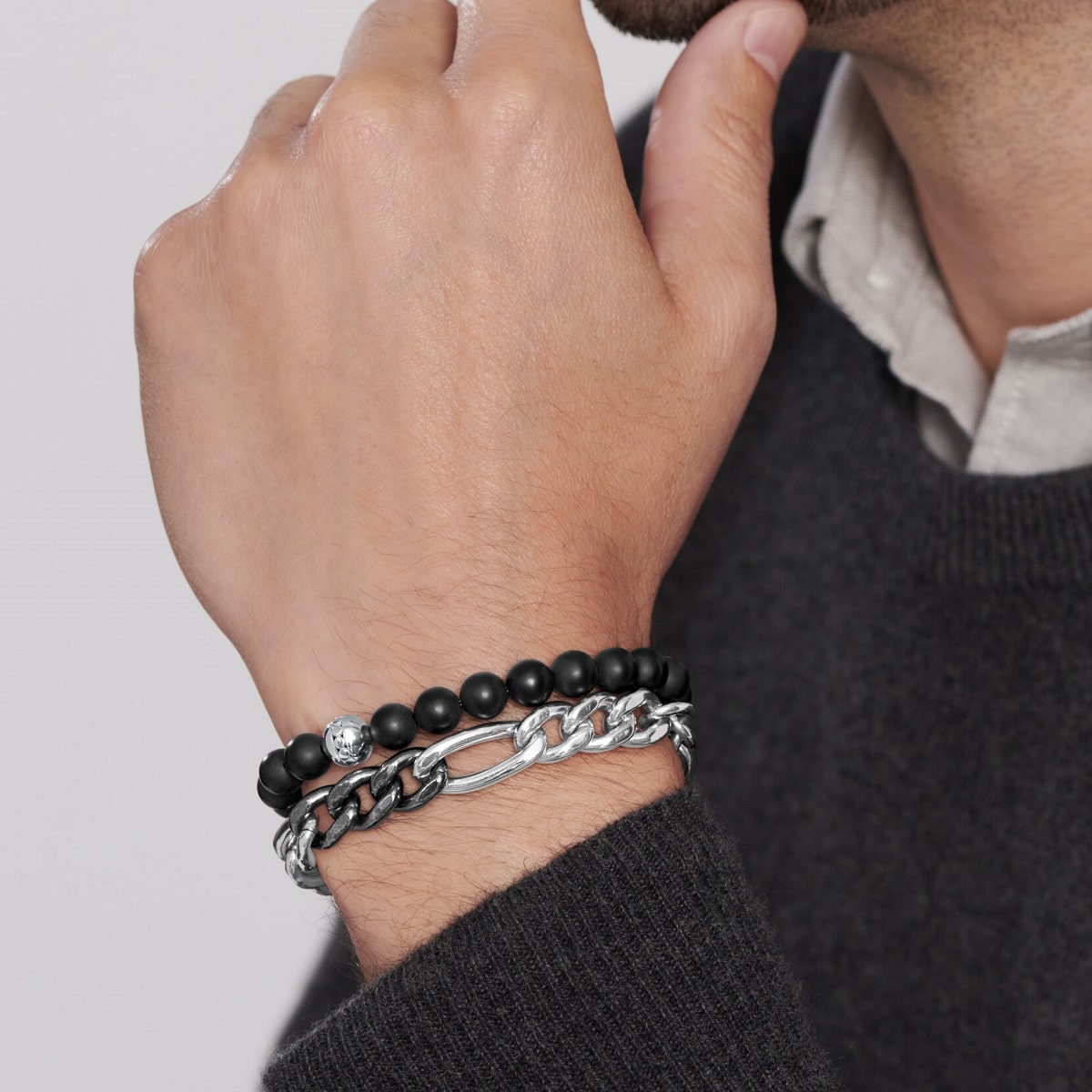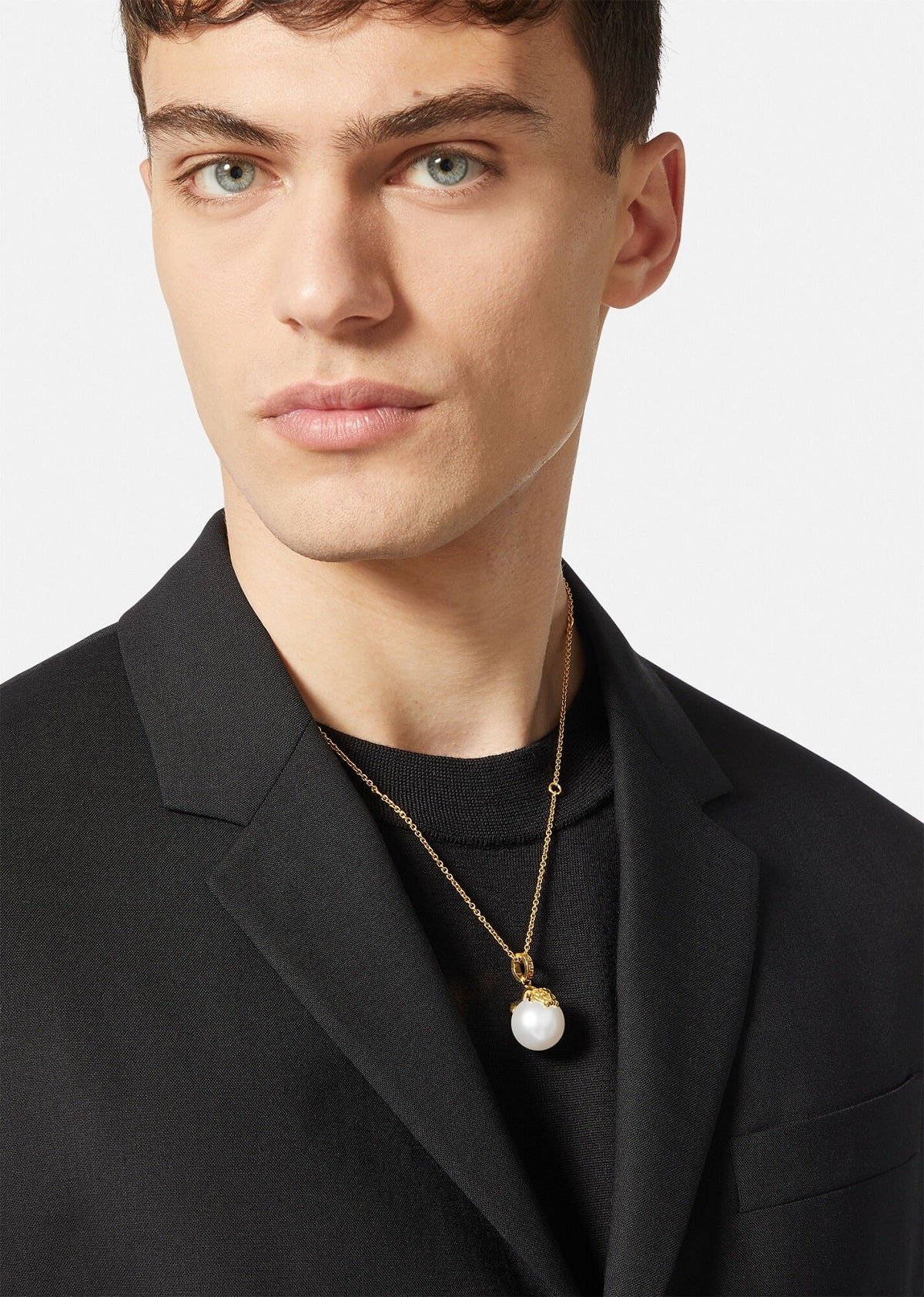1
HOME > Tips & Advice >
RULES FOR WEARING MEN’S JEWELRY
Written by Ivan Yaskey in Tips & Advice on the 10th November 2022

It used to be that men’s jewelry started with cufflinks and watches and maybe ended with a modest chain pendant necklace or woven bracelet. We don’t have to tell you: The times have changed, and we’re living in a “Why not try it?” culture. This attitude has brought pearl necklaces, more prominent rings, and bigger, flashier pieces into the fold. Still, accessories fall in line with your clothing. Rules change with settings and dress codes, and a classic-rooted mindset gives you more mileage than something exclusively trend driven. Especially if you’re new to the world of men’s jewelry, here’s how you can get started:
Stay Simple
With clothing, a foundation of navy, grays, and whites provides more versatility than, say, a plethora of pastels, patterns, and neon. Jewelry, to some extent, reflects this: Restrain yourself with embellishments, be it stones or engravings, and prioritize higher-quality metals and leathers. This means seek out stainless steel, as well as solid silver, gold, platinum, and tungsten. This aspect, however, establishes your baseline, where you can grow upward or in any direction you choose. Should you begin to venture from here, be selective: look for darker, smaller single stones rather than massive rocks or intense clusters. For the most part, this aesthetic really only tends to work with women’s engagement rings and proves to be too intense and chaotic in other contexts.

Aim for Understated
Think about the purpose jewelry serves. Sure, some see it as a status symbol – see luxury watch collecting as one example. But, from an ensemble angle, it functions as an accent – a touch of metal for shimmer and, in more of a classic sense, to break up the borderline monotony of greys and neutral hues. Metals alone have this effect – and the wider or more abundant they are, the greater the result tends to be.
In this direction:
- Be cautious with oversized pieces, as even those without embellishments feel like an automatic “look at my wealth” statement. Only athletes and musicians can get away with this. Instead, aim for a narrow to medium-width profile with a smooth, streamlined silhouette.
- Consider the proportions of your body versus your jewelry. The thinner you are, the larger oversized pieces are going to be. To the other end, if you’re someone with a larger or more muscular build, a simple chain or narrower watch will likely go unseen.
Match Your Metals
The jewelry world, in more recent years, has leaned toward mixing metals – a specifically, an evenly distributed cornucopia of yellow golds and silver tones. Occasionally, a subtler rose gold or deeper gun metal enters the fold. Still, with subtlety being paramount, this juxtaposition feels like a secondary element of your ensemble that simultaneously manages to appear prominent.
Unless you’re intentionally striving for flashy:
- Select one type of metal: For instance, only yellow gold pieces, exclusively silver tones from sterling, white gold, or platinum, or darker metals, like tungsten alongside gunmetal plating.
- Consider metal tone in relation to what you’re wearing. Silver pairs better with cooler greys and blues, while yellow gold accents browns, deeper greens, and select warm tones.
- Also don’t ignore your skin tone. Similarly, silvery metals better compliment cooler skin tones, gold is a stronger match for a warmer skin tone, and both tend to flatter neutral hues. Check the jewelry in natural light for a more accurate assessment.

Be Deliberate with Stones
Gemstones, no matter how pricey, can go one of two ways. One, an overabundance of them – say, in clusters, over the surface of a pendant, or even a pavé setting on a ring – gets noticed, giving off the impression that you have flashy, somewhat trend-driven tastes. Building off this, the combination – particularly when designed to accent fire and luminescence, as can be the case with diamonds – shimmers like a Christmas tree or lighthouse on the coast. The brightness causes others to take note and overshadows everything else about you. Secondly, despite the shift toward more androgynous menswear, gemstones read as distinctively feminine. Think elaborate diamond necklaces, engagement rings, and even bracelets. Although men’s jewelry leans more in this direction, it only really grasps at the realm of classic women’s pieces – like tennis bracelets, chains, and the aforementioned pearls. While the next step isn’t too far off, “occasion” pieces have yet to enter menswear vernacular. In turn, should you look for something with stones, be selective – one or two spaced out, preferably in a dark tone, like onyx, turquoise, or sapphire, or only partially translucent to bring down the visual brilliance.
Think About Connotations
Men might not yet have “occasion” pieces for jewelry, but styles toward the other end – casual and fashion – have grown exponentially. While this makes experimentation more accessible, it also means you’re more likely to run into cheap, flimsy construction: Think nickel or something gold plated that wears away with time. Outside of metals, this encompasses leather necklaces and cuffs, as well as wood. As we’ll address shortly, these latter two materials seem better suited to a teen’s wardrobe or might give off counterculture vibes – think S&M or rebel motorcycle club, depending on construction and number of studs. In this case, you’re better off leaving these pieces to the weekend. Outside of material, realize that you’re also going to encounter critics and questioners who will ask, “So, what does it mean?” You, of course, are thinking, “But I like it” or “It looks cool.” Fair enough, but at the same time, some kind of symbolism has accompanied men’s jewelry for decades. The wedding ring, based on placement, is obvious. From here, class and signet rings showed educational and organizational affiliation, respectively. Watches, meanwhile, may have been passed down as heirlooms. In turn, while much of the current tide can be attributed to style for style’s sake, don’t ignore placement, design, and what they could signify.

Consider the Dress Code
These days, working from home has opened up a whole new realm of style freedom. We’re not talking about athleisure and drawstring trousers, however, but more like experimentation in terms of colors, silhouettes, and accessories. If no one’s seeing you, except for an hour or two on Zoom, you don’t have to worry about office gossip or getting an email from HR. Still, especially as society resumes some degree of normalcy, you have places to be, and may be expected to dress for your environment. In terms of dress codes and jewelry:
- Err toward traditional for the workplace, even if your office has fully transitioned to smart-casual. This encompasses wedding bands, cufflinks, watches, the occasional lapel pin, or something modest in a solid metal. Go especially understated for an interview.
- Weddings: Also keep this traditional, particularly where your watch is concerned. Avoid anything overly embellished, look for modest pieces that match your suit, and seek out a narrower, leather-banded dress watch.
- Funerals: This should be a given: Due to the occasion’s somberness, avoid any jewelry, except for a simple pair of cufflinks and a dress watch.

Trending
2
3
4
5
6
7
8
9
10










